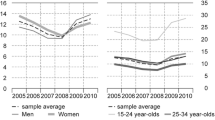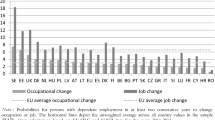Abstract
This chapter provides prima facie evidence of the geographical distribution of worker turnover within Italian regions as measured based on the longitudinal files of the labour force survey (LFS) for the period 2004–2010. It explains the stylized facts emerging from this enquiry with an interpretation based on the industrial change literature. Industrial turbulence, rather than labour market flexibility, is driving labour turnover within regions, as the correlation with the Lilien (positive) and the Herfindahl (negative) indices, respectively, shows. In other words, industrial change causes greater job destruction and flows into and out of unemployment, while, as also Alfred Marshall noted, the availability of more specialised districts could partly offset the diseconomies of specialisation in terms of greater exposure to external shocks, when the unit of analysis is sufficiently large, as it is in our case (NUTS1 and NUTS2). We also find that, at an individual level, the regional gap in turnover rates is due to regional differences in the gender, age and education attainment of the workforce, as well as the share of temporary work contracts and the size of firms.
JEL Classification C33, J63, P25, P52, R23
Access this chapter
Tax calculation will be finalised at checkout
Purchases are for personal use only
Similar content being viewed by others
Notes
- 1.
- 2.
For details on the theoretical framework, see Pastore (2012).
- 3.
For details on the HHI index, see Mussida and Pastore (2012).
- 4.
- 5.
The Lilien index is computed by using the STATA command Lilien as explained in Ansari et al. (2014).
- 6.
For shortness sake we omit the estimates, which are, however, available upon request.
References
Aghion, P., & Blanchard, O. (1994). On the speed of transition in central Europe (NBER Macroeconomics Annual) (pp. 283–320).
Ansari, M. R., Mussida, C., & Pastore, F. (2014). Note on Lilien and modified Lilien index. The Stata Journal, 9, 398–406.
Armstrong, H., & Taylor, J. (1985). Spatial variations in the male unemployment inflow rate. Applied Economics, 17(1), 41–54.
Bagnasco, A., Piselli, F., Pizzorno, A., & Trigilia, C. (2001). Il capitale sociale – Istruzioni per l’uso. Bologna: Il Mulino.
Basile, R., Girardi, A., Mantuano, M., & Pastore, F. (2012). Sectoral shifts, diversification and regional unemployment: Evidence from local labour systems in Italy. Empirica, 39(4), 525–544.
Berg, A. (1994). Does macroeconomic reform cause structural adjustment? Lessons from Poland. Journal of Comparative Economics, 18(3), 376–409.
Boeri, T. (1996). Is job turnover countercyclical? Journal of Labour Economics, 14(4), 603–625.
Boeri, T. (2000). Structural change, welfare systems, and labour reallocation. Oxford: Oxford University Press.
Boeri, T., & Scarpetta, S. (1996). Regional mismatch and the transition to a market economy. Labour Economics, 3(3), 233–254.
Burgess, S. M. (1993). A model of competition between unemployed and employed job searchers: An application to the unemployment outflow rate in Britain. The Economic Journal, 103, 1190–1204.
Carillo, R., & Zazzaro, A. (Eds.). (2001). Istituzioni, capitale umano e sviluppo del Mezzogiorno. Naples: ESI.
Carillo, M. R., Moro, B., Papagni, E., & Vinci, S. (Eds.). (2008). Dualismo, nuove teorie della crescita e sviluppo del Mezzogiorno. Bologna: Il Mulino.
Centorrino, M., & Ofria, F. (2001). L’impatto criminale sulla produttività del settore privato dell'economia. Milano: Giuffrè.
Centorrino, M., La Spina, A., & Signorino, G. (1999). Il nodo gordiano. Criminalità economica e Mezzogiorno. Bari: Laterza.
Chiarini, B., & Piselli, P. (2000). Unemployment, wage pressure and sectoral shifts: Permanent and temporary consequences of intersectoral shifts. Journal of Policy Modelling, 22(22), 777–799.
Contini, B. (2002). Labour mobility and wage dynamics. Torino: Rosemberg and Sellier.
Contini, B., & Trivellato, U. (2005). Eppur si muove. Dinamiche e persistenze nel mercato del lavoro italiano. Bologna: Il Mulino.
Daniele, V., & Marani, U. (2011). Organized crime, the quality of local institutions and FDI in Italy: A panel data analysis. European Journal of Political Economy, 27(1), 132–142.
Davis, S., & Haltiwanger, J. (1995). Measuring worker and job flows (NBER, Working Paper no. 5133).
Davis, S., Haltiwanger, J., & Schuh, F. (1996). Job creation and destruction. Cambridge, MA: MIT Press.
Del Monte, A., & Papagni, E. (2001). Public expenditure, corruption, and economic growth: The case of Italy. European Journal of Political Economy, 17(1), 1–16 (Elsevier).
Discenza, A., & Lucarelli, C. (2009). Dati longitudinali a 12 mesi di distanza – Aspetti metodologici. Roma: ISTAT.
Elhorst, J. P. (2003). The mystery of regional unemployment differentials. Theoretical and empirical explanations. Journal of Economic Surveys, 17(5), 709–748.
Ferragina, A. M., & Pastore, F. (2008). Mind the gap: Unemployment in the new EU regions. Journal of Economic Surveys, 22(1), 73–113.
Fujita, S., & Ramey, G. (2009). The cyclicality of separation and job finding rates. International Economic Review, 50(2), 415–430.
Garonna, P., & Sica, F. (2000). Intersectoral labour reallocations and unemployment in Italy. Labour Economics, 7(6), 711–728.
Glaeser, E., Kallal, H., Scheinkman, J., & Shleifer, A. (1992). Growth in cities. Journal of Political Economy, 100(6), 1126–1152.
Hyclak, T. (1996). Structural changes in labour demand and unemployment in local labour markets. Journal of Regional Science, 36(4), 653–663.
ISTAT. (2006). La rilevazione sulle forze di lavoro: contenuti, metodologie, organizzazione (Metodi e Norme, Vol. 32). Roma: ISTAT.
ISTAT. (2009). Nota metodologica allegata alla diffusione dei file MFR, Dicembre 2009.
Jacobs, J. (1969). The economy of cities. New York, NY: Random House.
Krajnyàk, K., & Sommer, M. (2004). Czech Republic (IMF Country Report, n. 4/265, August).
Krugman, P. (1994). Past and prospective causes of high unemployment. Economic Review, 79, 23–43.
Lilien, D. M. (1982). Sectoral shifts and cyclical unemployment. Journal of Political Economy, 90(4), 777–793.
Lopolito, A., & Sisto, R. (2007). Il capital sociale come fattore di sviluppo locale. Aspetti teorici e applicativi (N. 7). quaderni del Dipartimento di Scienze Economiche, Matematiche e Statistiche, University of Foggia.
Marshall, A. (1890). Principles of economics. London: Macmillan.
Mussida, C., & Pastore, F. (2012). Is there a Southern-sclerosis? Worker reallocation and regional unemployment in Italy (IZA Discussion Paper No. 6954), Bonn.
Naticchioni, P., Rustichelli, E., & Scialà, A. (2006). Employment protection and regional labour market flows. Economia Politica, 23(3), 453–474.
Neumann, G. R., & Topel, R. H. (1973). Employment risk, diversification, and unemployment. Quarterly Journal of Economics, 106(4), 1341–1365.
Newell, A., & Pastore, F. (1999). Structural change and structural unemployment in Poland. Studi Economici, 69(3), 81–100.
Newell, A., & Pastore, F. (2006). Regional unemployment and industrial restructuring in Poland. Eastern European Economics, 44(3), 5–28.
OECD. (1994). The OECD jobs study. Paris: OECD.
OECD. (2004). The OECD jobs study. Paris: OECD.
Pastore, F. (2012, December). Primum vivere … industrial change, job destruction and the geographical distribution of unemployment. IZA Journal of European Labor Studies, 1(7).
Pastore, F., & Tyrowicz, J. (2012). Labour turnover and the spatial distribution of unemployment. A panel data analysis using employment registry data (IZA Discussion Paper, No. 7074).
Robson, M. (2001). Regional variations in the competitiveness of unemployed job-seekers and the rate of out-flows from unemployment. Oxford Bulletin of Economics and Statistics, 63(1), 61–90.
Robson, M. (2009). Structural change, specialization and regional labour market performance: Evidence for the UK. Applied Economics, 41(3), 275–293.
Rutkowski, J. (2003). Rapid labour reallocation with a stagnant unemployment pool: The puzzle of the labour market in Lithuania (World Bank, Policy Research Working Paper Series, No. 2946).
Shimer, R. (2007). Reassessing the ins and outs of unemployment (NBER Working Papers, No. 13421).
Simon, C. J. (1988). Frictional unemployment and the role of industrial diversity. Quarterly Journal of Economics, 103(4), 715–728.
Simon, C. J., & Nardinelli, C. (1992). Does unemployment diversity always reduce unemployment? Evidence from the great depression and after. Economic Enquiry, 30(2), 384–397.
World Bank. (2001, March). Poland-labor market study: The challenge of job creation. Washington, DC: World Bank Country Study.
Acknowledgements
We thank two anonymous referees for their useful comments. The usual disclaimer applies.
Author information
Authors and Affiliations
Corresponding author
Editor information
Editors and Affiliations
Rights and permissions
Copyright information
© 2015 Springer-Verlag Berlin Heidelberg
About this chapter
Cite this chapter
Mussida, C., Pastore, F. (2015). Worker Turnover Across Italian Regions. In: Mussida, C., Pastore, F. (eds) Geographical Labor Market Imbalances. AIEL Series in Labour Economics. Springer, Berlin, Heidelberg. https://doi.org/10.1007/978-3-642-55203-8_2
Download citation
DOI: https://doi.org/10.1007/978-3-642-55203-8_2
Publisher Name: Springer, Berlin, Heidelberg
Print ISBN: 978-3-642-55202-1
Online ISBN: 978-3-642-55203-8
eBook Packages: Business and EconomicsEconomics and Finance (R0)




